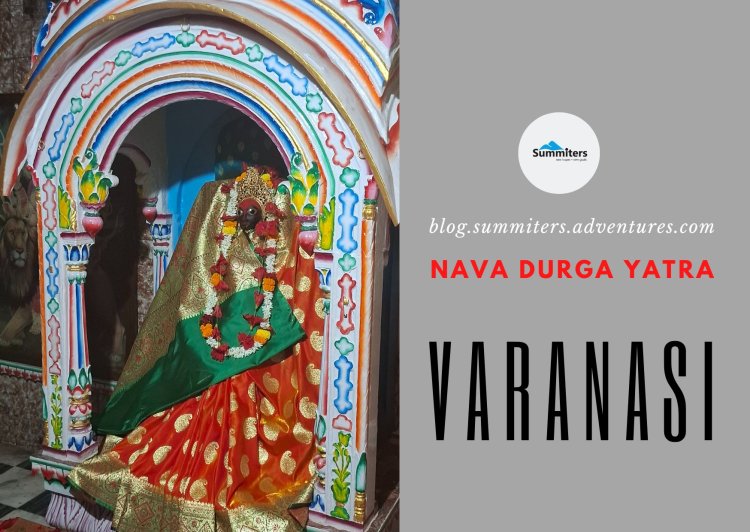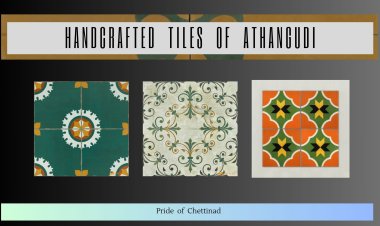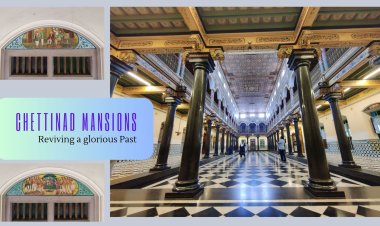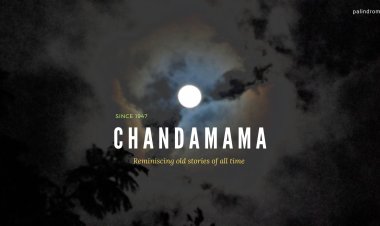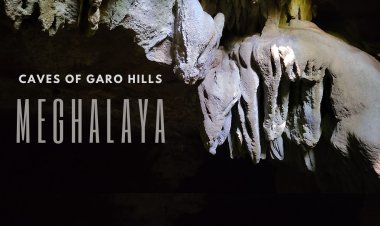Nava Raathri Nava Durga temple tour - Varanasi
Goddess Parvathi - The nine manisfestations of Durga is worshipped as nava durga She is a form of “Shakti”. The evolution of Shri Maha Saraswati, Shri Maha Laxmi and Shri Mahakali (the 3 main forms of “Shakti”) took place from Shri Brahma, Shri Vishnu and Shri Mahesh respectively. Each of these 3 deities gave rise to 3 more forms and hence in all, these 9 forms together are known as Navadurga. The nine forms of Durga are worshipped during the nine days of Navrathri.During the visit to temple capital varanasi, a visit to goddess of shakti,a offbeat tour in the alleys of Varanasi would be a divine experience of a lifetime
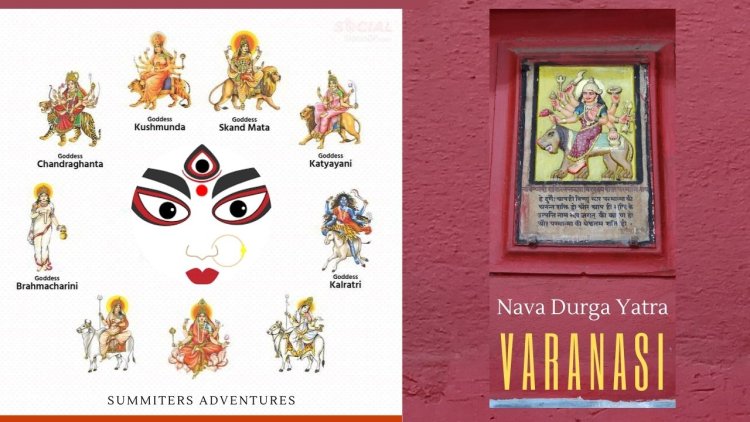
Kashi Khand of Skanda Purana, the most holiest &largest of all 18 Puranas mentions the importance of Kashi and auspious pilrimage to Navadurga shrines located in Varanasi.
During Navaratri I decided to visit Varanasi after the festivity season, during Maha Navarathri to avoid rush.
After greeting the Lord, i made my way through narrow alleys to decipher the less known shrines of durga matha i
Navaratri, the word is formed using two words ‘Nava’ and ‘Rathri’. Nava means nine and Ratri means nights hence Navratri literally means nine nights.
Little did i know that Navarathri Festival is celebrated 4 times a year. Until i learnt from local saint performing austerities in the ghat.
Navaratri is celebrated four times a year, during the Navratri Festival the nine manifestations of Goddess Durga are revered and worshipped for nine nights and ten days. The four different Navratri that are celebrated are
Magh Navratri, also known as Gupt Navratri (January – February),
Vasant Navratri, also known as Chaitra Navratri (March – April),
Ashad Navratri, also known as Gupt Navratri (June – July) &
Shardiya Navratri, also known as Maha Navratri (September – October).
Out of these four Navaratris the Vasant Navratri and Shardiya Navratri are especially considered important and auspicious by devotees.
The nine forms of Mata Durga which is worshipped during Navratri are:
Shailputri on Pratipada , Brahmacharini on Dwitiya,Chandarghanta on Tritiya, Kushmanda on Chaturthi, Skand Mata on Panchami, Katyayani on Shashthi, Kaalratri on Saptami, Mahagauri on Ashtami , Siddhidatri on Navami.
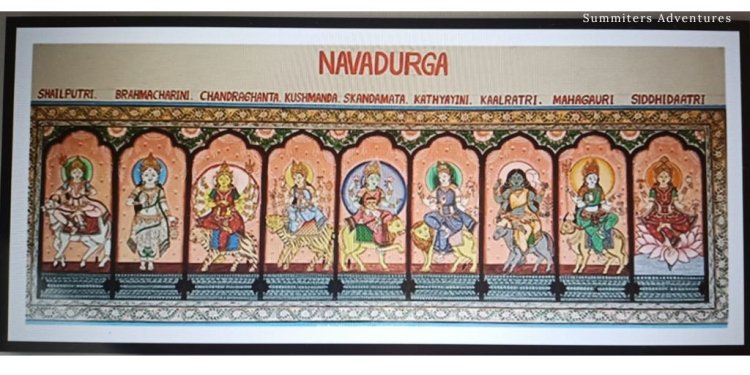 1. Mata Shailputri – The daughter of the mountain
1. Mata Shailputri – The daughter of the mountain
The first form of Durga is Shailputri or the daughter of the Himavat or mountain.The King of Mighty Himalayas.She is also known as Sati, Hemavathi and Bhavani. Their are many songs in the praise of himagiri thanaye hemalathe Shail also means rock, which means she is not yet in her active state. She has just taken birth. Her journey begins from here. She is represented, and shown as riding a bull, holding Trishul or trident in one hand and a lotus in another.
Location
In Varanasi, her temple is located close to Marhia Ghat. The rickshaw drivers would take you upto main road as temple is located in narrow by lanes. It is a small temple complex containing many temples.You need to take help of signboard and locals to reach temple
In the main temple is a Shivalinga, with a Nandi facing it in the Mandapa. On one side is the Murti in the sanctum is idol of Mata Shailputri.Only few tourists visit this temple.During my visit the Murti was completely covered with a flowers, but thankfully the face was visible.After paying obeisance to devi,i stepped out of the temple
I was told that during Navarathri, their will be a beeline in the bylanes leading to the temple.
2. Mata Brahmacharini – The Ascetic form of Devi
A avatar of Devi worshipped on the second day of Navaratri is called Brahmacharini. This is the ascetic form of Parvati when she did tough penance to get Shiva as her husband. As an ascetic, she adorns simple clothes and holds a Rudraksha Mala and a Kamadala or water pot in her hand.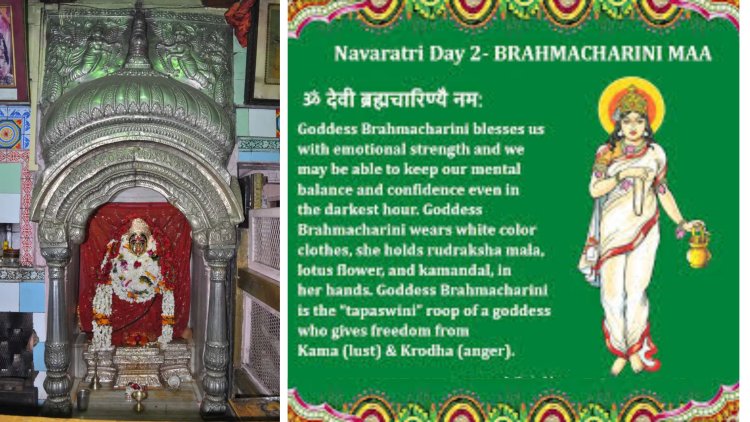 Location
Location
In Kashi, her temple is located close to Durga Ghat or Brahma Ghat. One can approach both from the city side or from the ghats. It is again a small shrine, the lanes have graffitis painted with scenes of Kashi. Outside the temple, a marble plaque has the Brahmacharini mantra engraved on it. The Murti of Mata Brahmacharini is beautiful and is adorned with clothes, flowers, and jewellery. Like in every Devi temple, there is a Shivalinga facing the goddess
3. Mata Chandraghanta Devi – One with a Bell-shaped moon on her forehead
Chandraghanta is the third form of Devi worshipped on the 3rd day of Navaratri.The bell-shaped moon on her forehead is her distinctive feature. She rides a lion and has ten hands sporting different weapons or Ayudhas, and at the same time providing Abhaya or protection to her devotees. In this form, she is worshipped as Durga who fights evil or ensure protection for those who come to her.
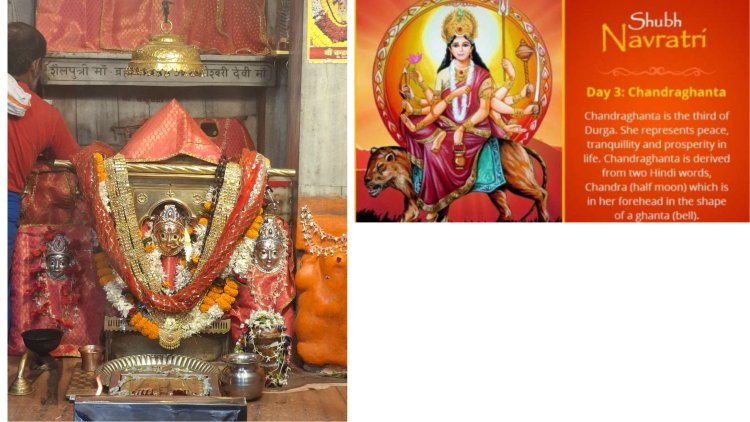
Location
4. Mata Kushmanda – The Cosmic Egg
Considered as the 4th form of Durga is Kushmanda which refers to her as a cosmic egg from which the whole Shrishti or creation is said to have happened. She is ashta bahu or 8 armed, weilding many weapons and auspicious symbols, seated on her celestial vehicle lion. She represents the Hiranyagarbha and is resplendent with golden color
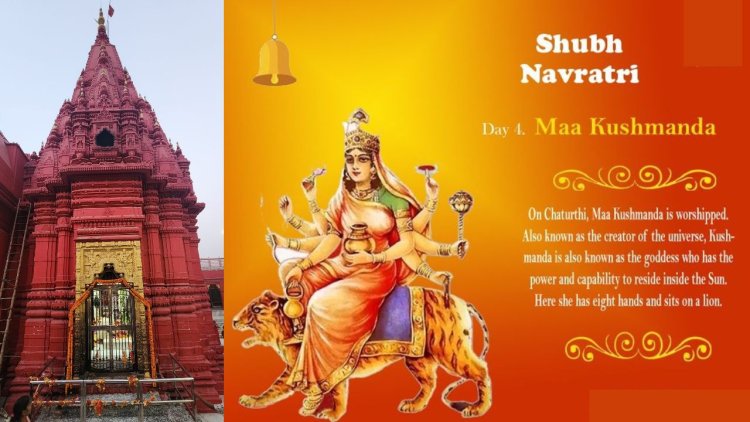
Location
-
5. Mata Skandamata – The mother of Skanda
Said to be the 5th form of Durga is as the mother of Skanda or Karthik – the six-headed commander of the Devas army. As a nurturing mother, she is seated on a lion holding her son in her lap and holding two lotuses in her two hands and protecting the devotees with the fourth. Alternatively, she is also shown seated on a lotus as she is also Padmasana.
Location
In Varanasi, Skandamata temple is located in Jaitpura area, close to Jaitpura Police Station.In a temple complex more popularly known as Bageshwari Devi temple. The temple is located at two levels from ground, the lower level has Bageshwari Devi who is actually Ashwarooda meaning she rides a horse. Her temple opens only twice in the year, the rest of the days, people pray through the closed door only.
Skandmata is located on the upper floor and this is where people come and worship regularly. During the Navadurga circuit, this is visited on the 5th day. This temple is unique as a female priest performs puja here.
6. Kathyayini – The Embodinent of Power
-
Katyayini is the warrior form of Devi, who killed Demon Mahishasura. As she was worshipped by Rishi Katyayan in that form, she received the name Katyayani - As his daughter. In Kashi, there is another story of her in the form of Vikata Devi, who helped a prince of Kashi reach the Swarga - heaven and come back. She is worshipped on the 6th day of Navaratri.
Katyayani is a four-armed goddess riding a lion, holding a lotus and a sword in two arms while the other two bless and protect devotees. She is known as of remover all sufferings.
This Temple is at Agnisvara Ghat which is near to Pancha ghat. Another Katyayani Temple is in premises of Atma Veereswarer Temple which is near Sankat ghat. Sankat ghat is between the Manikarnika and Panchaganga ghats.
7.Mata Kalarathri – The dark night
Kalarathri has a diverse meaning. One is the cyclic night that follows the day. It refers to the end of an era when the creation dissolves and merges back with the Brahman - The creator. It is after this night that a new cycle of creation begins. She is also the goddess who emitted fire by merely exhaling during war with evil In Kashi, she guards the city as Kshetrapalini like many other goddesses.
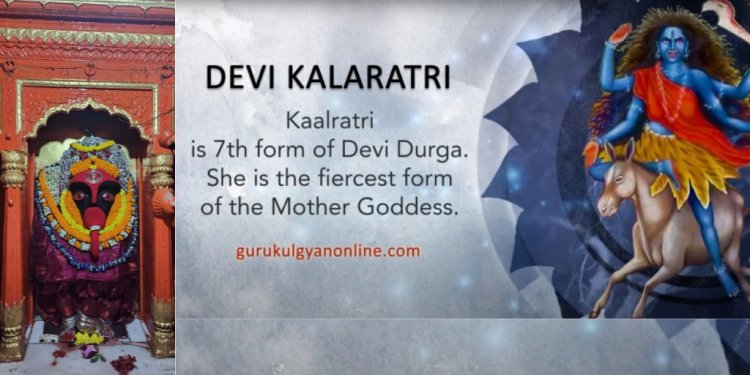
Representing the night, Kalaratri is depicted with a dark black complexion, blood-red eyes, hair swaying everywhere, and a garland of lightning and flames coming from her mouth. She holds a Chandrahasa sword and Vajra or thunderbolt in two of her four arms and rides a donkey. Although looks fearsome, she bestows auspiciousness and is hence also called Shubhakari. In fact worshipiing her removes all your fears.
-
In Varanasi, the Kalarathri temple is located in Kalika Gali, which is parallel to Vishwanath Gali and is named after this Devi. It is at a walkable distance from the famous Dashaashwamedh Ghat. She is also worshipped as Kali and the temple is treated as a Shakti Peetha. During Navadurga Yatra she is visited on the 7th day.
8. Mata Mahagauri – The Goddess with a fair complexion
Mahagauri is Parvati in her most benevolent form and it is evident in her vehicle white bull. In three of her four hands, she carried the Trishul or trident, Damruk, and lotus.
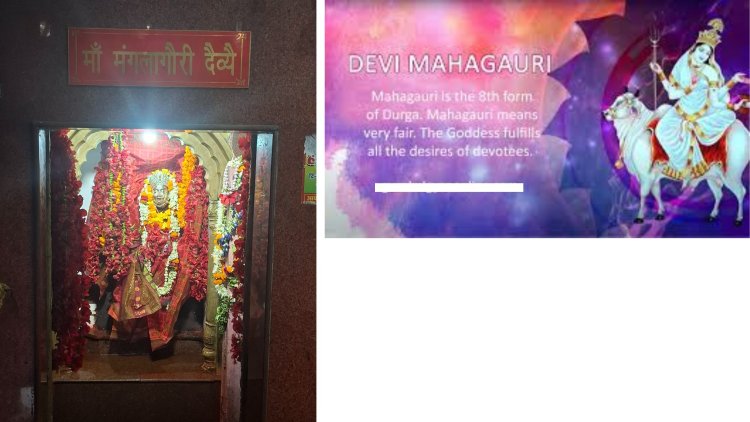
In Kashi, the presiding Devi of the city – Maa Annapurna is also the Mahagauri – the eighth form of Durga that is worshipped on the 8th day of Navaratri. Her temple, right next to Kashi Vishwanath temple is one of the most popular temples in the city. There is no way you should miss it. Annapoorna - Food giving goddess temple is a must-visit as and when you are visiting Kashi. This temple is always full of devotees. On few Other special occassion at this temple include Dhanteras till Diwali Amavasya when her golden Murti is opened for darshan on the upper floor of the temple.
On Chaitra Shukla Ashtami i.e., the eighth day of the Chaitra or Vasant Navatari there is a tradition of doing 108 pradakshina or Parikrama of Mata Annapurna.There is another small Adi Annapurna temple close to this temple. Not many people visit it, but it has a very unique Murti. You need to request Pujari Ji to show it to you.
- Note - Free meals,Refreshments in the evening, and breakfast @ Sri Annapurna Matha Mandir , Sri Vishwanath Gali as maha prasadham is provided to all devotees without caste and creed. I was fortunate to taste the food.
- Eat what you take ; Take what you eat - Finally Dont waste food
-
 9. Mata Siddhidatri – The bestower of all Siddhis or the super natural powers
9. Mata Siddhidatri – The bestower of all Siddhis or the super natural powers
The final and 9th form of Durga is Siddhidatri. In this form, she is the giver of different Siddhis - Perfection. The name Siddhidatri is made by combining two words where Siddhi means ‘supernatural powers’ and Datri means ‘provider’. Hence, Maa Siddhidatri is called the Goddess or provider of Supernatural powers.

There are eight Siddhis listed in Puranic literature collectively called Ashta - Siddhi. As the name itself says Ashta which means eight in sanskrit, the ashta siddhis are: Anima, Mahima, Garima, Laghima, Prapti, Prakamya, Isitva, Vasitva. Each siddhi governs certain character or certain aspect of nature and mastering each gives one distinct ability unique to other siddhis.
She is visited and worshipped on the 9th day of Navadurga Yatra during Navarathri. The priest at the temple told me that it is a Siddhapeetha and many rishis are still meditating here in their Sukshma or subtle form. You can feel the peaceful aura of the place that has been worshipped for a very long time.
Location
In Kashi, she is located in Siddhmata Gali in Siddheshwari Mohalla – all of which are named after her. Her temple complex also houses the Chandreshwar Mahadev temple which is believed to have been set up by Chandra or the moon himself and is believed to pre-date Kashi Vishwanath temple. There is an ancient well called Chandra Koop whose water is still used for Abhishek in the temple.
If you notice, every form of Goddess has celestial vehicle and Lotus associated with her, either she is holding it in her hand or she is sitting on one. Lotus is the symbol of purity, of growing in mud and yet retaining its purity, of not allowing any impurity to stay on it.
Every idol in the temple is unique and have positive energy and after darshan, on meditating one can experience inner peace in the abode of devis
